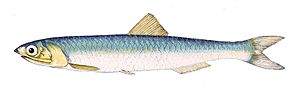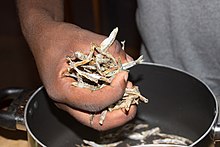European anchovy
| European anchovy | |
|---|---|

| |
| Scientific classification | |
| Domain: | Eukaryota |
| Kingdom: | Animalia |
| Phylum: | Chordata |
| Class: | Actinopterygii |
| Order: | Clupeiformes |
| Family: | Engraulidae |
| Genus: | Engraulis |
| Species: | E. encrasicolus
|
| Binomial name | |
| Engraulis encrasicolus | |
TheEuropean anchovy(Engraulis encrasicolus) is aforage fishsomewhat related to theherring.It is a type ofanchovy;anchovies are placed in the familyEngraulidae.It lives off the coasts of Europe and Africa, including in theMediterranean Sea,theBlack Sea,and theSea of Azov.It is fished by humans throughout much of its range.[1]
Etymology
[edit]This species can be fished from the shore with simpler gear, such asbeach seines,[1]and it has been widely-eaten for millennia.[2]The species has been fished since ancient times.[1]Both the species name, "Engraulis"(ἐγγραυλίς), and the specific name "encrasicolus"(ἐγκρασίχολος) are names fromAncient Greek,meaning "anchovy" and "small fish" respectively.[3]
Description
[edit]
It is easily distinguished by its deeply cleft mouth, the angle of the gape being behind the eyes. The pointed snout extends beyond the lower jaw. The fish resembles a sprat in having a forked tail and a single dorsal fin, but the body is round and slender.[citation needed]The record weight for a single fish is 49 g (1.7 oz).[4]The maximum recorded length is21 cm (8+1⁄8in).[citation needed]13.5 cm (5.3 in) is a more typical length.[5]It has a silver underbelly and blue, green or grey back and sides.[4]A silver stripe along the side fades away with age.[5]
Habitat and ecology
[edit]The European anchovy is a coastalpelagicspecies; in summer, it usually lives in water less than 50 m deep (although, in the Mediterranean, it goes to depths of 200 m in winter), and it may go as deep as 400 m. As it iseuryhaline,it can live in water with a salinity of 5–41[1]PSU(sea watersalinityis usually 35 PSU[6]). It can therefore live inbrackish waterinlagoons,estuaries,andlakes.[1]
European anchovies eatplankton,mostlycopepodsand the eggs andlarvaeof fish,molluscs,andcirripedes.[7]They are migratory, often travelling northwards in summer and south in winter. They form largeschools,[1]and may formbait ballswhen threatened (see image, below).
European anchovies are eaten by many species of fish, birds and marine mammals.[4]
Life cycle
[edit]The species spawn multiply[5]in warm periods from about April to November, depending on when the temperatures are warm enough. At least some local subpopulations have separate spawning grounds, and are thus genetically distinct,[1]although spawning grounds shift.[5]Some spawn in fresh water. The shape of the eggs is ellipsoidal to oval.[5]The eggs float asplanktonin the upper 50 m of thewater columnfor about 24–65 hours before hatching. The hatched larvae are transparent and grow rapidly; a year later, in the unlikely event that they survive, they will be 9–10 cm (3.5–3.9 in) long.[1]The females are larger than the males.[8]When they reach a length of 12–13 cm (4.7–5.1 in), they spawn for the first time. A survey in southwestern Africa found no specimens older than three years.[1]
Distribution
[edit]Europe
[edit]
European anchovies are abundant in theMediterraneanand formerly also theBlackandAzovseas (see below). They are regularly caught on the coasts ofBulgaria,Croatia,France,Georgia,Greece,Italy,Albania,Romania,Russia,Spain,TurkeyandUkraine.The range of the species also extends along the Atlantic coast of Europe to the south ofNorway.In winter it is common off Devon and Cornwall (United Kingdom), but has not hitherto been caught in such numbers as to be of commercial importance.
Zuiderzee and English Channel
[edit]Formerly they were caught in large numbers off the coast of theNetherlandsin summer when they entered theWadden SeaandZuiderzee.After the closing of theZuiderzeethey were still found in the Wadden Sea until the 1960s. They were also caught in the estuary of theScheldt.
There is reason to believe that anchovies at the western end of theEnglish Channelin November and December migrate from theZuiderzeeand theScheldtin the autumn, returning there the following spring. They were believed to be an isolated population, for none come from the south in summer to occupy theEnglish Channel,though the species does exist off the coast ofPortugal.The explanation appears to be that in summer, the shallow and landlocked waters of the Zuiderzee and the sea off the Dutch coast get warmer than the coastal waters off Britain, so anchovies can spawn and maintain their numbers in warmer Dutch waters better.
Dutch naturalists on the shores of the Zuiderzee first described their reproduction and development. Spawning takes place in June and July. The eggs are buoyant and transparent like most fish eggs, but are unusual in being sausage-shaped, instead of globular. They resemble sprat andpilchardeggs in having a segmented yolk and no oil globule. Larvæ hatch two or three days after fertilization, and are minute and transparent. In August young specimens, c.38 to 89 mm (1+1⁄2to3+1⁄2in) in length, are found in the Zuiderzee, and these must derive from the previous summer's spawning.
There is no evidence to decide the question whether all the young anchovies as well as the adults leave the Zuiderzee in autumn, but, considering the winter temperature there, it is probable that they do. Eggs have also been found in theBay of Naples,nearMarseilles,off the coast of theNetherlands,and once at least off the coast ofLancashire.The occurrence of anchovies in the English Channel has been carefully studied at theMarine Biological AssociationLaboratory inPlymouth.They were most abundant in 1889 and 1890. In the former year considerable numbers were taken off Dover in drift nets of small mesh used for the capture of sprats. In the following December large numbers were taken together with sprats at Torquay. In November 1890 a thousand of the fish were obtained in two days from the pilchard boats fishing near Plymouth; these were caught near the Eddystone.
Mediterranean, Black Sea and Azov Sea
[edit]
In areas around the Black Sea, the European anchovy is calledgávros(Γαύρος) inGreek,hamsieinRomanian,ქაფშია (Kapshia) or ქაფშა (Kapsha) inGeorgian,hamsiinTurkish,hapsiin Pontic dialect of Turkish,hapsia(plural) inPontic Greek,Hapchia inLaz,[9]хамсия(hamsiya) inBulgarian,andхамса(hamsa) inRussianandUkrainian.ItsAncient Greekname was ἀφύη,aphýē,laterLatinizedintoapiuva,hence thestandard Italianacciugaand theCroatianinćunthrough theGenoese dialectalanciúa.Modern Greekalso uses αντζούγιαantsúya,a variant of the Genoese form, for processed – as opposed to the freshgávros– anchovy products.
Black Sea adult anchovies can reach around12–15 cm (4+1⁄2–6 in). In the summer,hamsimigrates north to warm shallow waters of theAzov Seato feed and breed, returning to the deep for the winter by migrating through theStrait of Kerch.During migration the fish moves in hugeschools,and are actively hunted bygullsanddolphins.Hamsimakes up a considerable part offishingandfish processingindustries, eithercannedor frozen. In Turkey, it is the staple food of the local Black Sea cuisine,[10]widely used in pan dishes, baked goods, even as dessert. In Bulgariahamsiyais traditionally fried and served in cheap fast-food restaurants along the shore, typically withbeer.Since the 1990s the dominant position of friedhamsiyais fading but still popular. In Spain, they are called “anchoa” or “boquerón”, when they are eaten pickled. They are so typical inMalagathat the inhabitant of this Andalusian city is also called “boquerón”.
Anchovy populations in the Mediterranean were severely depleted in the 1980s by theinvasivecomb jellyMnemiopsis leidyiwhich eats the eggs and young, they have since stabilized albeit at a much lower level.
Off Africa (East Atlantic and West Indian Oceans)
[edit]
European anchovies are commercially important down the west coast of Africa, although they are most abundant at the north end of this range. The species is most commercially important inMorocco.InMauritania,artisanal fishers do not target the species, and commercial fisheries have size limitations.
InWest Africa,these anchovies are widely fished and eaten. InNigeria,Ghana,andBenin,it is an abundant and important commercial species. After the end of the upwelling season ends theSardinellafishery, fishers change net size to catch anchovies. InGuinea,the Gambia,andSenegal,it is not an important commercial species.
South of theAngola/Namibiaborder,Engraulis encrasicolus(the European anchovy) mixes withEngraulis capensis,the South African anchovy. The Namibian fishery is significantly involved in fishmeal and fish oil production.
European anchovies are also found inupwellingareas off the east coast of Africa.[1]
Fisheries
[edit]
The IUCN considers the fisheries to be abundant and fully exploited, and in need of careful monitoring.[1]The highly international species has no concerted management plan.[5]
Local populations fluctuate, and have shown large fluctuations in the past.[1]These fluctuations are not well understood.[5]Some past declines have been due to environmental problems, localoverfishing,andinvasive speciesfromballast water.Mnemiopsis leidyiis an invasive species which eats European anchovy eggs.[1]Some past fluctuations are likely due toclimate change.[4]
European anchovies are caught withpurse seines,lamparas,trawlsandbeach seines.[1]Bycatch is thought, on the basis of insufficient data, to be minor.[5]
Human uses
[edit]
European anchovies are widely eaten.[1]Anchovies are considered anoily fish;they have a salty, strong taste. Some people eat them raw.[4]European anchovies are sold fresh, dried, smoked, salted, in oil, frozen, canned, and processed into fishmeal and fish oil.[4][1]Their ease of preservation has made them a traditional item for long-distance trade.[4]Anchovies are also used asfishing bait.[1][8]
See also
[edit]Notes
[edit]- ^abcdefghijklmnopqrTous, P.; Sidibé, A.; Mbye, E.; de Morais, L.; Camara, Y.H.; Adeofe, T.A.; Monroe, T.; Camara, K.; Cissoko, K.; Djiman, R.; Sagna, A.; Sylla, M. & Carpenter, K.E. (2015)."Engraulis encrasicolus".IUCN Red List of Threatened Species.2015:e.T198568A15546291.doi:10.2305/IUCN.UK.2015-4.RLTS.T198568A15546291.en.Retrieved12 November2021.
- ^Thring, Oliver (18 January 2011)."Consider the anchovy".The Guardian.Retrieved30 September2018.
- ^"Family ENGRAULIDAE Gill 1861 (Anchovies)".The ETYFish Project.31 March 2023.Retrieved3 January2024.
- ^abcdefg"European Anchovy".britishseafishing.co.uk.12 March 2014.Retrieved26 September2018.
- ^abcdefgh"FishSource – European anchovy – Black Sea".fishsource.org.Retrieved26 September2018.
- ^Culkin, F.; Smith, N. D. (1980). "Determination of the Concentration of Potassium Chloride Solution Having the Same Electrical Conductivity, at 15 C and Infinite Frequency, as Standard Seawater of Salinity 35.0000 ‰ (Chlorinity 19.37394 ‰)".IEEE J. Oceanic Eng.OE-5(1): 22–23.Bibcode:1980IJOE....5...22C.doi:10.1109/JOE.1980.1145443.
- ^Mustać, Bosiljka; Hure, Marijana (15 July 2020)."The diet of the anchovy Engraulis encrasicolus (Linnaeus, 1758) during the spawning season in the eastern Adriatic Sea".Acta Adriatica.61(1): 57–66.doi:10.32582/aa.61.1.4.
- ^abhttp://aquaticcommons.org/9289/1/na_2684.pdf[bare URL PDF]
- ^Özhan Öztürk.Karadeniz Ansiklopedik Sözlük. 2005. pp. 486–488
- ^Black Sea Region cuisine of TurkeyArchivedMay 11, 2012, at theWayback Machine
References
[edit]- Froese, Rainer; Pauly, Daniel (eds.) (2005)."Engraulis encrasicolus"inFishBase.October 2005 version.
- Kube, Sandra; Postel, Lutz; Honnef, Christopher & Augustin, Christina B.(2007):Mnemiopsis leidyiin the Baltic Sea – distribution and overwintering between autumn 2006 and spring 2007.Aquatic Invasions2(2): 137–145.


